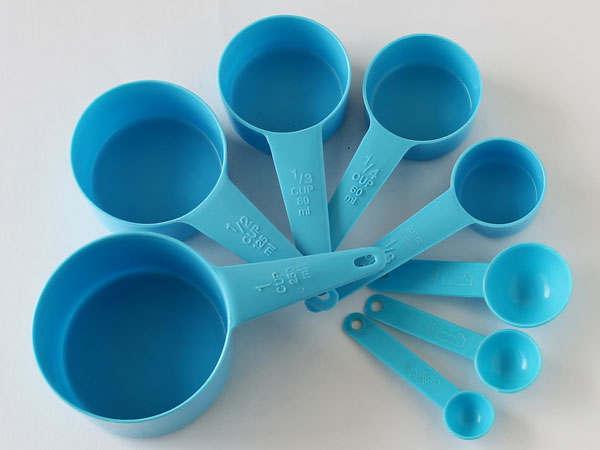Cooking Measurements and Conversions

| Common Cups to Tablespoons and Teaspoons Conversion Chart | |
| 1 cup | 16 Tablespoon |
| 1/2 cup | 8 Tablespoon |
| 1/4 cup | 4 Tablespoon |
| 1/8 cup | 2 Tablespoon |
| 1 Tablespoon | 3 Teaspoon |
| 1/2 Tablespoon | 1.5 Teaspoon |
| 1 Pinch | 1/8 Teaspoon |
To measure dry ingredients like flours, sugar, semolina, spices powder, etc., fill the measuring cup or measuring spoon with the ingredient up to brim and then level it with back edge of a knife or a spatula.
Many dry ingredients, such as granulated sugar, are not very compressible, so volume measures are consistent. However others, notably flour, are more variable. For example, 1 cup of all-purpose flour sifted into a cup and leveled with technique mentioned above weighs about 100 grams, whereas 1 cup of all-purpose flour scooped from its container and leveled weighs about 140 grams. Wherever required, our recipes also mention to use compressed or uncompressed quantities.
Using a measuring cup to measure bulk foods, which can be compressed to a variable degree such as chopped vegetables or shredded cheese leads to large measurement uncertainties and it is recommended to chop the vegetables and fruits into pieces for a correct measure.
| Conversion Chart for Typical Dry Ingredients Used In Our Recipes | ||
| Name | 1 cup Equals | 1/2 cup Equals |
| Whole Wheat Flour | 120 gm | 60 gm |
| Maida (all purpose flour) | 120 gm | 60 gm |
| Gram Flour (besan) | 150 gm | 75 gm |
| Semolina | 200 gm | 100 gm |
| Raw Rice (uncooked) | 200 gm | 100 gm |
| Lentils (dals) | 200 gm | 100 gm |
| Granulated Sugar | 200 gm | 100 gm |
| Powdered Sugar | 120 gm | 60 gm |
To measure liquid ingredients specified in quantity higher than a cup, place a measuring jug (large cup) on flat surface, pour the liquid in it and check it at eye level to measure. To measure liquid ingredients specified in quantity smaller than cup, use tablespoons, teaspoons and smaller cups (1/2 cup, 1/4 cup, 1/3 cup).
| Conversion Chart for Liquid | |
| 1 cup | 250 ml |
| 3/4 cup | 188 ml |
| 2/3 cup | 165 ml |
| 1/2 cup | 125 ml |
| 1/3 cup | 83 ml |
| 1/4 cup | 60 ml |
| 1/8 cup | 30 ml |
| 1 tablespoon | 15 ml |
| 1/2 tablespoon | 7.5 ml |
| 1 teaspoon | 5 ml |
| 1/2 teaspoon | 2.5 ml |
You can easily by measuring cups set and spoons from local utensil store or from online store. Click on the links given below to purchase it from your favorite website.
